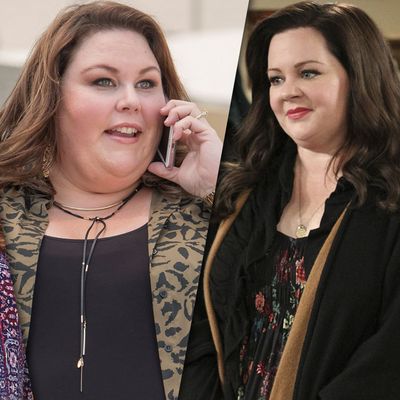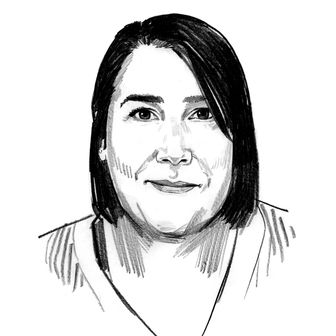
When NBC’s This Is Us debuted last fall, it got people talking — about its rarely seen, immediate success; about a return to the heartfelt, earnest TV drama; about Milo’s butt.
But what I was most interested in was what people were saying about Chrissy Metz and her character, Kate Pearson.
Like many other fat women, I was cautiously optimistic about the portrayal of someone who looks like me on scripted television. The idea of inclusion was exciting, but we’ve been burned before. So many times. This could be different, right? This would be a fat woman as a main character on a network television drama. A rarity. After several episodes, two things were clear: First, Chrissy Metz gives a glorious, layered, now Emmy-nominated performance. Second, the story that This Is Us — which returned for season two last night — has decided to tell with Kate leaves something to be desired. Many people took to these interwebs, including yours truly, to bemoan the fact that Kate’s season-one story is entirely enmeshed in her weight. She gets story lines about her love life, about finding work, about her thorny relationship with her mother — but they all have to do with her weight. In the second episode, Kate even tells us herself: “It’s always going to be about the weight for me … It’s at the core of who I am.” We read you loud and clear, writers. Metz does wonderful things with the material she’s given, but Kate Pearson is a fat woman, and that’s really all she has time to be.
But maybe that criticism isn’t entirely fair, especially when you consider other examples of fat women on television.
The idea of a fat woman who is completely and solely defined by her weight isn’t new. It’s why for so long — and even still in recent instances — the fat woman existed only to be the butt of (lazy) jokes. Sitcoms have always been the biggest offenders when it comes to making fun of fat people. How I Met Your Mother, in which playboy Barney Stinson (Neil Patrick Harris) repeatedly demeans fat women without much reprimand from his friends (in case you’re skeptical, here’s a handy list). They don’t even show us the fat women he makes fun of because all we need to know about them is that they’re fat.
In most discussions regarding fat women on television, Fat Monica (Courteney Cox) on Friends is usually the first one name-checked. She’s constantly ridiculed, both in the present as a thin woman who was once fat, and in flashbacks to her overweight past. The “joke” being that she was fat. Isn’t that hilarious? Sookie (Melissa McCarthy) from Gilmore Girls is never asked to comment on her weight and is presented with zero self-esteem issues, but her buddies Lorelei (Lauren Graham) and, especially, Rory (Alexis Bledel) have no problem blasting people for their weight. What would Sookie think about Rory’s ballet review (season four’s “Die, Jerk”) in which she refers to the lead ballerina as a hippo, only shows remorse once she’s called out for it, and in the end suffers zero consequences? Sookie would have notes.
The fat-woman-as-a-joke extends to present-day protagonists, too. Take American Housewife, for example. The titular housewife, Katie (Katy Mixon), feels like an outcast in her Stepford Wife–ish Connecticut town mostly because she’s fat. Except here, it’s Katie doing the name-calling. The pilot is about her fear of becoming the second fattest woman in her town. She spends the entirety of it loathing herself and searching for someone bigger than her to move in across the street. Katie is defined by her “otherness,” and what makes her “other” is the fact that she’s fat. And this is our heroine, people.
Where This Is Us differs is that it obviously treats Kate with an abundance of respect. The only people using fat in the pejorative sense are typically already seen as bad people (think Katey Sagal’s ruthless agent), whereas in the examples above, the ribbing is coming from characters we’re supposed to love. The message that comes from that is alarming.
As you start to deliberately seek out television shows with fat female characters, another trend begins to emerge: In many of the instances in which a fat woman graces the TV screen as a lead, the entire premise of the show has to do with weight. As if the only way to explain why the focus of a show would be on a fat woman is to make the show about weight. ABC Family’s Huge, about teens at a weight-loss camp, CBS’s Mike & Molly, about a couple who meets at an Overeaters Anonymous meeting, and Lifetime’s Drop Dead Diva, which, bear with me here, is about a shallow model who dies and comes back to life in a size 16 lawyer’s body, all provide fat female leads, but are all shows where weight plays a major factor throughout. The good news is that those three female leads (Nikki Blonsky, Melissa McCarthy, and Brooke Elliott, respectively) are all so endearing that they easily elevate their characters over many of the fat people tropes they’re forced to endure.
In Drop Dead Diva’s case, the show barrels through most of those stereotypes in the first few episodes and ends up simply being a cutesy dramedy about a lawyer with great lipstick game, who happens to be fat. It’s more about finding your soul mate than dealing with issues of weight. (If you can get through the premise, you’re in for a real treat, mainly thanks to Elliott.) Especially for Diva and Huge, it’s as if a weight-related premise is the Trojan horse by which people are able to sneak women with diverse body types onto TV.
Or, you know, they could just cast women with diverse body types and let them be. Thankfully, there are more examples of this type of fat woman cropping up on TV (keep in mind, “more” is relative): take Grey’s Anatomy and Orange Is the New Black, which present women who run the gamut in size, without having to talk about it ad nauseum, or at all, really. These shows owe a lot to the OG, Roseanne. Roseanne Connor (Roseanne Barr) didn’t look like anyone else on TV, and she never apologized for it (diets were used as plot points here and there, but never in a self-loathing type of way). And her name was on the front door.
Perhaps most telling, though, is the fact that shows featuring fat women who have no physical hang-ups still get blowback from viewers. When Gabourey Sidibe’s character Becky got her very own sex scene on Empire — which, by the way, lasts less than a minute — in season two, Sidibe had to spend actual time defending the scene. Even if TV creators are ready to treat fat women as, you know, women, some of the viewing public can’t wrap their heads around the fact that fat women also have sex, deal with drama at work, and can get into hilarious hijinks that have nothing to do with their weight.
Like any group that is underrepresented on television, the only true fix is for a wider range of stories being told. We shouldn’t be lambasting This Is Us for having Kate fixated on her weight. For some fat women, Kate’s story is their story, just as some fat women relate more to a character who embraces or doesn’t feel the need to talk about her weight. We need to acknowledge the fact that no one portrayal of a certain person is indicative of all people who look like her. The problem This Is Us has isn’t that it gives Kate story lines in which she deals with her weight, it’s that her weight is her only real character trait. Randall, Rebecca, Jack, even Kate’s fiancé Toby, are better developed characters than she is.
There is, thankfully, some hope. In the season-two premiere, Kate goes on an audition, in which she feels dismissed because of her weight. She takes her rejecters to task, only for them to inform her that their “no” had nothing to do with her weight at all, but her ability to sing. The girl needs practice! Is this entire exchange This Is Us being meta? Is Kate realizing that it’s not always about the weight the show attempting to say they understand that as well and are working to correct that? Only time will tell, but my fingers are crossed.


